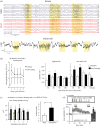A mechanism for learning with sleep spindles
- PMID: 32248788
- PMCID: PMC7209910
- DOI: 10.1098/rstb.2019.0230
A mechanism for learning with sleep spindles
Abstract
Spindles are ubiquitous oscillations during non-rapid eye movement (NREM) sleep. A growing body of evidence points to a possible link with learning and memory, and the underlying mechanisms are now starting to be unveiled. Specifically, spindles are associated with increased dendritic activity and high intracellular calcium levels, a situation favourable to plasticity, as well as with control of spiking output by feed-forward inhibition. During spindles, thalamocortical networks become unresponsive to inputs, thus potentially preventing interference between memory-related internal information processing and extrinsic signals. At the system level, spindles are co-modulated with other major NREM oscillations, including hippocampal sharp wave-ripples (SWRs) and neocortical slow waves, both previously shown to be associated with learning and memory. The sequential occurrence of reactivation at the time of SWRs followed by neuronal plasticity-promoting spindles is a possible mechanism to explain NREM sleep-dependent consolidation of memories. This article is part of the Theo Murphy meeting issue 'Memory reactivation: replaying events past, present and future'.
Keywords: coupling; memory; plasticity; reactivation; sleep; spindles.
Conflict of interest statement
We have no competing interests.
Figures





Similar articles
-
Experience and sleep-dependent synaptic plasticity: from structure to activity.Philos Trans R Soc Lond B Biol Sci. 2020 May 25;375(1799):20190234. doi: 10.1098/rstb.2019.0234. Epub 2020 Apr 6. Philos Trans R Soc Lond B Biol Sci. 2020. PMID: 32248786 Free PMC article. Review.
-
A sleep spindle framework for motor memory consolidation.Philos Trans R Soc Lond B Biol Sci. 2020 May 25;375(1799):20190232. doi: 10.1098/rstb.2019.0232. Epub 2020 Apr 6. Philos Trans R Soc Lond B Biol Sci. 2020. PMID: 32248783 Free PMC article. Review.
-
Neural ensemble reactivation in rapid eye movement and slow-wave sleep coordinate with muscle activity to promote rapid motor skill learning.Philos Trans R Soc Lond B Biol Sci. 2020 May 25;375(1799):20190655. doi: 10.1098/rstb.2019.0655. Epub 2020 Apr 6. Philos Trans R Soc Lond B Biol Sci. 2020. PMID: 32248776 Free PMC article.
-
Coordination of Human Hippocampal Sharpwave Ripples during NREM Sleep with Cortical Theta Bursts, Spindles, Downstates, and Upstates.J Neurosci. 2019 Oct 30;39(44):8744-8761. doi: 10.1523/JNEUROSCI.2857-18.2019. Epub 2019 Sep 18. J Neurosci. 2019. PMID: 31533977 Free PMC article.
-
Cortical Ripples during NREM Sleep and Waking in Humans.J Neurosci. 2022 Oct 19;42(42):7931-7946. doi: 10.1523/JNEUROSCI.0742-22.2022. Epub 2022 Aug 30. J Neurosci. 2022. PMID: 36041852 Free PMC article.
Cited by
-
A model of autonomous interactions between hippocampus and neocortex driving sleep-dependent memory consolidation.Proc Natl Acad Sci U S A. 2022 Nov;119(44):e2123432119. doi: 10.1073/pnas.2123432119. Epub 2022 Oct 24. Proc Natl Acad Sci U S A. 2022. PMID: 36279437 Free PMC article.
-
Evolution of cross-frequency coupling between endogenous oscillations over the temporal cortex in very premature neonates.Cereb Cortex. 2022 Dec 20;33(2):278-289. doi: 10.1093/cercor/bhac067. Cereb Cortex. 2022. PMID: 35235654 Free PMC article.
-
Two distinct ways to form long-term object recognition memory during sleep and wakefulness.Proc Natl Acad Sci U S A. 2022 Aug 23;119(34):e2203165119. doi: 10.1073/pnas.2203165119. Epub 2022 Aug 15. Proc Natl Acad Sci U S A. 2022. PMID: 35969775 Free PMC article.
-
A Role for δ Subunit-Containing GABAA Receptors on Parvalbumin-Positive Neurons in Maintaining Electrocortical Signatures of Sleep States.J Neurosci. 2025 May 14;45(20):e0601242025. doi: 10.1523/JNEUROSCI.0601-24.2025. J Neurosci. 2025. PMID: 40204438
-
Information maximization explains state-dependent synaptic plasticity and memory reorganization during non-rapid eye movement sleep.PNAS Nexus. 2022 Dec 10;2(1):pgac286. doi: 10.1093/pnasnexus/pgac286. eCollection 2023 Jan. PNAS Nexus. 2022. PMID: 36712943 Free PMC article.
References
-
- Berger H. 1929. Über das Elektrenkephalogramm des Menschen. Arch. Für Psychiatr. Nervenkrankh. 87, 527–570. (10.1007/BF01797193) - DOI
Publication types
MeSH terms
Grants and funding
LinkOut - more resources
Full Text Sources
Miscellaneous

